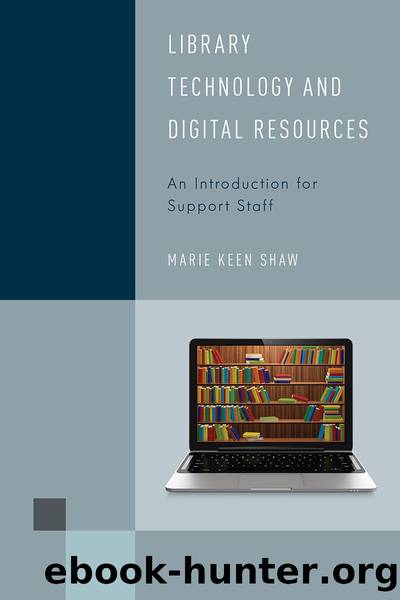Library Technology and Digital Resources by Marie Keen Shaw

Author:Marie Keen Shaw
Language: eng
Format: epub
ISBN: 9781442256453
Publisher: Rowman & Littlefield Publishers
MULTIMEDIA
Multimedia is digital film, sound recordings, or combinations of both. Most patrons seek multimedia from their libraries for either research or entertainment. Patrons may want to research âhow toâ do a task or to enhance their learning about a topic. They may also want to view movies to be entertained, relieve stress, relax, follow a favorite performerâs work, or even just to fill a time void. There are many reasons why library patrons seek multimedia from their libraries, and LSS are often involved with helping them make selections by sharing favorites and reviews. LSS often recommend multimedia to patrons but, more importantly, with the onset of streaming video services, they may be called upon to help patrons set up accounts or devices.
Libraries have several options for multimedia service. They may purchase their own hard copies of media, or purchase subscriptions or licenses to stream video from services. There are also many purposeful free multimedia sites available on the Internet. DVD collections are standard and are still in use in most libraries. Some large academic or school libraries host their media on a central console and network it to classrooms or users in the building. These central distributing systems can be thought of as a local network for multimedia. The systems are expensive and often require trained staff to manage. LSS who work in school libraries that have this kind of equipment may be trained to manage the system and support users. Benefits of such systems are a control of content by the institution, simultaneous and proprietary rights to the media, and immediate access by the users.
There are many companies that sell multimedia to libraries, schools, and the public, offering different packages and prices (see table 7.3). Netflix is a leader in entertainment and film for the public although many schools also use Netflix to support the curriculum. Discovery16 offers full curriculum support, Kâ12, with streaming video aligned to learning standards. Local cable companies may also offer streaming video of television programs and movies to libraries. Check with the company in your area to see what they may be able to do on a limited basis.
Information about movies is available through databases. Internet Movie Data-base17 offers film information, including credits, plot summaries, character names, movie ratings, year of release, running times, soundtracks, country of production, genres, production companies, distributors, special effects companies, reference literature, filming locations, and movie trivia from 1892 to the present. Having this kind of information online is very helpful to patrons to make decisions about their viewing and replaces reference materials that were difficult to keep current.
Table 7.3. Examples of Streaming Video Services for Library Consideration
Name Description
Hoopla Hoopla is a digital platform which offers streaming movies, TV, music, and audiobooks. Think of it like a Netflix for libraries.
Freegal A library subscription service that offers over eight million songs and fifteen thousand music videos.
YouTube Free and universally popular self-posted shorts. Good for instructions and âhow to.â
Netflix Entertainment and classical films
Discovery Curriculum based for learning
PBS Videos Popular educational films
Overdrive
Download
This site does not store any files on its server. We only index and link to content provided by other sites. Please contact the content providers to delete copyright contents if any and email us, we'll remove relevant links or contents immediately.
Cecilia; Or, Memoirs of an Heiress — Volume 1 by Fanny Burney(32432)
Cecilia; Or, Memoirs of an Heiress — Volume 2 by Fanny Burney(31865)
Cecilia; Or, Memoirs of an Heiress — Volume 3 by Fanny Burney(31849)
The Great Music City by Andrea Baker(31319)
We're Going to Need More Wine by Gabrielle Union(18966)
All the Missing Girls by Megan Miranda(15557)
Pimp by Iceberg Slim(14375)
Bombshells: Glamour Girls of a Lifetime by Sullivan Steve(13970)
Talking to Strangers by Malcolm Gladwell(13218)
Norse Mythology by Gaiman Neil(13202)
Fifty Shades Freed by E L James(13157)
For the Love of Europe by Rick Steves(12910)
Mindhunter: Inside the FBI's Elite Serial Crime Unit by John E. Douglas & Mark Olshaker(9186)
Crazy Rich Asians by Kevin Kwan(9164)
The Lost Art of Listening by Michael P. Nichols(7403)
Enlightenment Now: The Case for Reason, Science, Humanism, and Progress by Steven Pinker(7226)
The Four Agreements by Don Miguel Ruiz(6617)
Bad Blood by John Carreyrou(6542)
Weapons of Math Destruction by Cathy O'Neil(6139)
